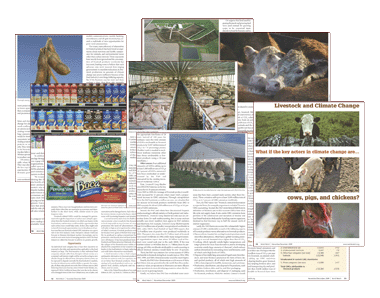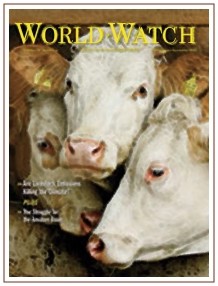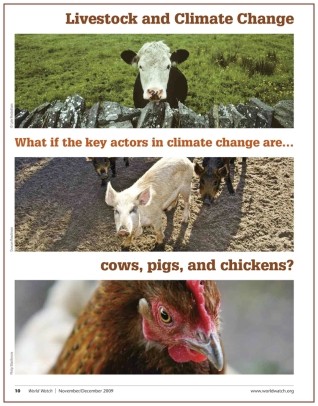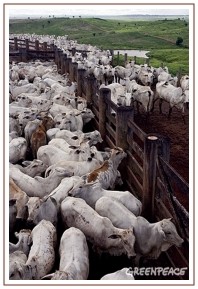| Save Our Planet
New Study: 51% of Greenhouse Gas Emissions Come from Livestock Industry
By USA News Group
(Originally in English)
A new study published in the November issue of World Watch Magazine has concluded that livestock production and its by-products are responsible for at least 51 percent of global warming. Authors Dr. Robert Goodland, former lead environmental advisor to the World Bank, and World Bank research officer Mr. Jeffery Anhang built upon a widely cited 2006 report “Livestock’s Long Shadow” by the United Nations Food and Agriculture Organization (FAO). After reviewing both direct and indirect sources of GHG emissions from livestock, they calculated and included areas not previously considered, and updated others. The following is a summary of their findings.
Livestock Respiration Overlooked Land Use Undercounted Effect of Methane The global warming potential of methane is 72 times that of CO2 (averaged over 20 years) or 25 times that of CO2 (averaged over 100 years). The FAO estimates livestock emissions to be 3.7% of the annual worldwide GHG emissions using the outdated potential of 23 times that of CO2 (averaged over 100 years). However, Goodland and Anhang believe using the 20-year average is more appropriate because of the huge effect that methane reductions can have within 20 years and the serious climate disruption expected within 20 years if no significant reduction of GHG is achieved. They estimate the effect of the methane emissions from livestock therefore to be 11.6%, an increase of 7.9% from the FAO’s estimate of 3.7%. Other Uncounted Categories Goodland and Anhang updated and corrected some data on which the FAO’s analysis is based. For example, they revised the amount of worldwide livestock products in 2002 with the amount in 2009 which increased 12%; and they replaced the understated 33.0 million tons of poultry produced worldwide in 2002 with the correct amount of 72.9 million tons. They also considered less efficiency in production in most developing countries than assumed in the FAO report. These categories of additional GHG emissions add up to at least 5,560 million tons of CO2e or 8.7% of the annual worldwide GHG emissions. Misallocated Sources Goodland and Anhang found a substantial amount of emissions that the FAO overlooks and counts under sectors other than livestock. These include Argentina, which the FAO excludes from livestock-related deforestation accounting; farmed fish, which the FAO excludes from the definition of livestock; fluorocarbons needed for cooling livestock products; zoonotic diseases (such as swine flu) and other diseases caused by animal products, such as heart disease and cancer, which require carbon-intensive medical treatment; disposal of livestock products; production, distribution, and disposal of by-products such as leather, feathers, skin and fur, plus their packaging; and cooking meat, which typically entails higher temperatures and longer time than alternatives. These emissions add up to at least 3,000 million tons of CO2e, or 4.7% of the annual worldwide GHG emissions. Goodland and Anhang believe this approach would not only achieve swift GHG emission reductions but would also help ease the global food crisis, as more calories can be produced directly from crops than from feeding them to livestock. They also believe that non-meat alternative products would help ease the global water crisis, as water necessary for livestock production would be freed up, and create both more jobs and more skilled jobs because non-meat alternatives would be more labor intensive than livestock projects. Our deep heartfelt appreciation, Dr. Goodland, Mr. Anhang,
participating scientists, and World Watch Institute, for your work
showing that meat consumption is clearly the single largest contributor
to greenhouse gas emissions. Let us ever more swiftly replace animal
products with their planet-cooling vegetarian alternatives to preserve
our ecosphere and all lives. 
Source: “Livestock and Climate Change,” World Watch Magazine http://www.worldwatch.org/node/6294 To watch the Supreme Master Television special program featuring “Meat and Global Warming: Uncovering Truths to Save the Planet”, please visit: http://video.godsdirectcontact.net/magazine/AW1147s.php
|
|||||||||||||||||||


 The
FAO does not count the CO2 produced by animals breathing. Goodland
and Anhang consider livestock to be like automobiles: both are essentially
human inventions, for our “convenience” but not survival.
Since we measure the direct emissions of automobiles, we should also
measure the direct emissions of livestock, which they estimate to
be 8,769 million tons of CO2 or 13.7% of the annual worldwide GHG
emissions.
The
FAO does not count the CO2 produced by animals breathing. Goodland
and Anhang consider livestock to be like automobiles: both are essentially
human inventions, for our “convenience” but not survival.
Since we measure the direct emissions of automobiles, we should also
measure the direct emissions of livestock, which they estimate to
be 8,769 million tons of CO2 or 13.7% of the annual worldwide GHG
emissions.
 Because
of the growth of the livestock industry, more and more land has been
converted from tropical forests, a huge carbon sink, to cattle grazing
or growing animal feeds, a comparatively tiny carbon sink. The FAO
only counts the emissions from initial changes in land use but not
the vast amounts of potential carbon absorption by trees which has
been lost by the conversions. Goodland and Anhang estimate this vast
amount to be 2,672 million tons of CO2e, or 4.2 percent of the annual
worldwide GHG emissions.
Because
of the growth of the livestock industry, more and more land has been
converted from tropical forests, a huge carbon sink, to cattle grazing
or growing animal feeds, a comparatively tiny carbon sink. The FAO
only counts the emissions from initial changes in land use but not
the vast amounts of potential carbon absorption by trees which has
been lost by the conversions. Goodland and Anhang estimate this vast
amount to be 2,672 million tons of CO2e, or 4.2 percent of the annual
worldwide GHG emissions.
 Based
on their research, Goodland and Anhang conclude that replacing livestock
products with soy-based and other alternatives would be the best strategy
for reversing climate change. They wrote, “This approach would
have far more rapid effects on GHG emissions and their atmospheric
concentrations - and thus on the rate the climate is warming - than
actions to replace fossil fuels with renewable energy.”
Based
on their research, Goodland and Anhang conclude that replacing livestock
products with soy-based and other alternatives would be the best strategy
for reversing climate change. They wrote, “This approach would
have far more rapid effects on GHG emissions and their atmospheric
concentrations - and thus on the rate the climate is warming - than
actions to replace fossil fuels with renewable energy.”